Lecture at Rhode Island School of Art and Design

After Everything Is Extracted: Artist Talk past Ruanne Abou-Rahme and Basel Abbas
How rich our mutability, how easily nosotros modify (and are inverse) from one matter to another, how unstable our identify—and all because of the missing foundation of our existence, the lost ground of our origin, the cleaved link with our land and our past...
— Edward West. Said, After the Last Sky
Following their exhibition, May amnesia never buss usa on the oral cavity, at the Dia Fine art Foundation and the MoMA (opening: April 23, 2022), RISD is hosting multimedia artists Ruanne Abou-Rahme and Basel Abbas. The creative person talk is followed by a Q&A. This even is free and open to the public.
This event is fabricated possible by the Turner Theatrical and Performance Blueprint Grant in conjunction with the Division of Liberal Arts' MA Program in Global Arts and Cultures (GAC), "Theories of the Epitome" graduate seminar, and "Ability, Pastness and Performances of Monumentality: An Immersive Seminar-Studio."
This event is organized by Avishek Ganguly (Literary Arts and Studies, Global Arts and Cultures), Christopher Roberts (Theory and History of Art and Design, Experimental and Foundation Studies), and Foad Torshizi (Theory and History of Fine art and Design, Global Arts and Cultures).
View Event →


Screening of Be Natural: The Untold Story of Alice Guy-Blaché
Synopsis
When Alice Guy-Blaché completed her first film in 1896 Paris, she was not but the first female filmmaker, but 1 of the first directors ever to make a narrative moving-picture show. Be Natural: The Untold Story of Alice Guy-Blaché follows her rise from Gaumont secretary to her appointment as head of production in 1897, and her subsequent illustrious 20-year career in France and in the Us, equally the founder of her ain studio and as writer, director, and/or producer of 1,000 films—after which she was veritably erased from history. Until now…. Directed by Pamela B. Dark-green, the movie is narrated past Jodie Foster.
Trailer
https://benaturalthemovie.com
Recent Press
LE MONDE: August 12, 2019: Emmanuelle Lequeux'south article on Alice Guy-Blaché mentions Exist Natural
https://www.lemonde.fr/festival/article/2019/08/12/la-cineaste-alice-guy-pres-de-mille-films-et-cent-ans-d-oubli_5498658_4415198.html
THE NEW YORK TIMES: April 25, 2019: AO Scott'southward review:
https://www.nytimes.com/2019/04/25/movies/be-natural-untold-story-alice-guy-blache-review.html?login=email&auth=login-email
THE NEW YORK TIMES: April 26, 2019: Elizabeth Weitzman's feature ran with artwork
https://www.nytimes.com/2019/04/26/movies/alice-guy-blache-be-natural.html
LOS ANGELES TIMES: Apr eighteen, 2019: Katie Walsh's positive review ran with artwork
https://www.latimes.com/entertainment/movies/la-et-mn-exist-natural-alice-guy-blache-review-20181120-story.html
DEADLINE:May fifteen, 2018: Pete Hammond's positive review from Cannes
http://deadline.com/2018/05/be-natural-director-pamela-b-green-alice-guy-blache-cannes-studio-1202390265/
View Event →

Interference Fringe: L.N. Tallur
An creative person's talk by L.N. Tallur
L.N. Tallur is a multimedia conceptual artist who divides his time between Bharat and Republic of korea. He was the winner of the 2012 Škoda prize for Indian contemporary fine art. His work explores the absurdities of everyday life and the anxieties of contemporary society. Information technology incorporates the organic, manus-made craftsmanship, institute objects, the industrial, and symbols of India, often correlating traditional and contemporary community. He received a BFA in Painting from Chamarajendra Academy of Visual Arts (1996), a MFA in Museology from Maharaja Sayyajirao Academy (1998), and an MA in Contemporary Fine Fine art Exercise from Leeds Metropolitan University (2002).
Sponsored by the Division of Liberal Arts, Global Art & Civilisation, and THAD in collaboration with Brown Academy, History of Art Department.
View Event →

Gradual Contemporary: Lynne Cooke
Battling BORDERS: INTERCHANGES Between UNCREDENTIALED ARTISTS AND AMERICAN VANGUARDS
Lynne Cooke
Since the terminal century, the human relationship between vanguard and cocky-taught artists has been defined by contradiction. The established art world has been quick to brand clear distinctions between trained and untrained artists, withal at the aforementioned fourth dimension it has been fascinated by outliers whom it draws selectively and intermittently into its orbits. Curator Lynne Cooke explores shifting conceptualizations of the American outlier across the twentieth century. She reveals how these distinctions take been freighted with a particularly American point of view as she investigates our assumptions virtually creativity, artistic practice, and the role of the artist in contemporary culture.
(Credit)
Lynne Cooke is the Senior Curator for Special Projects in Mod Art, National Gallery of Art, Washington DC, where she recently curated "Outliers and American Vanguard Fine art." Prior to her present position, she was the deputy director and master curator at the Museo Reina Sofia, Madrid, Spain, and the curator at the Dia Art Foundation. Cooke has taught and lectured regularly at the University College London, Syracuse Academy, Yale University, Columbia University, and the Center for Curatorial Studies at Bard College. She was a co-curator of the Venice Biennale in 1986, the Carnegie International in 1991, and was creative director of the Biennale of Sydney in 1996.
Dr. Cooke established herself during the mid-80s as a author on contemporary artists of the menstruation, including British sculptors Anish Kapoor and Bill Woodrow, and American creative person Allan McCollum. During her years at Dia, Cooke organized a number of exhibitions of younger American women artists and worked to bring greater recognition to women artists who contributed to the minimalist catamenia; she besides organized significant exhibitions aimed at introducing European artists of the 1980s to the American public.
Cooke has curated exhibitions at the Arnolfini Gallery, Bristol; Whitechapel Fine art Gallery and Hayward Gallery, London; Third Eye Center, Glasgow; Institute of Contemporary Fine art, Boston; Tamayo Museum, Mexico; and elsewhere. In 2006, she was the recipient of the Honour for Curatorial Excellence from the Middle for Curatorial Studies at Bard Higher, and in 2007, she co-curated the exhibition "Richard Serra Sculpture: Forty Years," at the Museum of Modern Art in New York. She has written widely about contemporary art in exhibition catalogues and in Artforum, Artscribe, The Burlington Magazine, and Parkett, amid other magazines.
View Event →
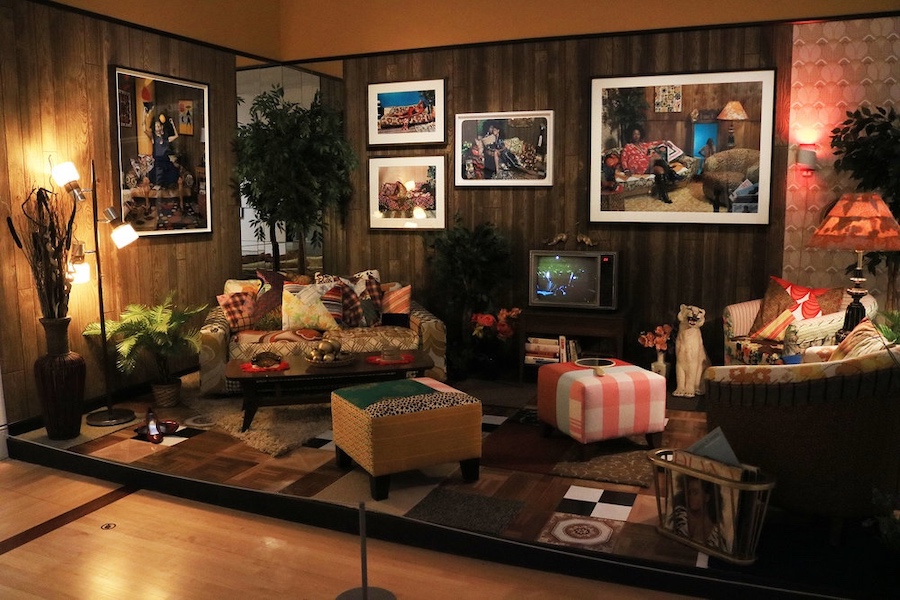
Fine art History Colloquium: Eric Anderson
MICKALENE THOMAS'S COZY CORNERS
My paper considers home decoration equally a topic situated within the varied terrain of vernacular material culture, design do, and artistic representation. Every bit a starting signal, I explore the domestic interiors portrayed past Mickalene Thomas in recent paintings, collages, photographs, and installations. Thomas collects and arranges decorative furnishings in her studio and in galleries, reviving a nineteenth-century artistic exercise for twenty-first century abode–makeover culture. Her collecting and display, in turn, provide the starting point for the production of a prolific trunk of domestic imagery. Thomas'south pictures of interiors follow a recognizable template with colorful, patterned, textile-laden surfaces that frame intimately enclosed spaces and languidly posed sitters. These gimmicky cozy corners suggest a cult of hyper-adorned domesticity steeped in historical motifs and ideological meanings. Yet the exaggerated eclecticism and unorthodox materials (rhinestones, wood paneling, wax-print fabrics) and the assertive presence of the black, queer women who inhabit Thomas's interiors bespeak an intention to critically reimagine onetime motifs for new subjectivities.
To better sympathize Thomas'southward disquisitional revisions of ornament and domesticity, I make comparisons to past imagery from nineteenth-century painting and photography, 1950s modernist architecture, and a 1970s decorating transmission. Thomas's appropriation of historical motifs too equally her engagement with historical practices of the studio and the gallery draw attention to persistent, oft hidden ways that dwelling house décor has been used to mark out boundaries of identity and belonging. Inspired past literary scholar Susan Fraiman's notion of "extreme domesticity"—homemaking as a radical assertion of agency from positions of marginalization—I emphasize ways that Thomas's exuberant décor subverts conventional definitions of gender, sexuality, and race in the home.
Eric Anderson studies and teaches the history of modernistic pattern. He has written on topics including exhibitions, color theory, Sigmund Freud'south office and the mass-marketing of furniture. Articles and reviews accept appeared in the journals West 86th, Centropa, Journal of Design History and Nineteenth-Century Art Worldwide and in books including Blueprint Dialogue: Jews, Civilisation and Viennese Modernism (Vienna, 2018), Making Dwelling: The Arts and Crafts Movement and the Reform of Everyday Life (New Haven, 2018), Klimt und der Ringstrasse (Vienna, 2015) and Performance, Fashion, and the Mod Interior (Oxford, 2011). He has lectured recently in China, Greece and the UK and spent a semester as a Fulbright Fellow at the Sigmund Freud Museum and Academy of Applied Arts in Vienna.
Pre-circulated paper
Please email thad@risd.edu to receive a copy or RSVP hither and nosotros will email you a copy.
Light refreshments will be served.
View Consequence →

Gradual Contemporary: Kader Attia
ON REPAIR
Kader Attia
For many years, Kader Attia has been exploring the perspective that societies take on their history, particularly as regards experiences of deprivation and suppression, violence and loss, and how this affects the evolving of nations and individuals — each of them being continued to collective memory.
His socio-cultural enquiry has led Kader Attia to the notion of Repair, a concept he has been developing philosophically in his writings and symbolically in his oeuvre as a visual artist. With the principle of Repair being a constant in nature — thus as well in humanity —, whatever system, social institution or cultural tradition can be considered equally an infinite process of Repair, which is closely linked to loss and wounds, to recuperation and re-appropriation. Repair reaches far beyond the subject and connects the individual to gender, philosophy, scientific discipline, and architecture, and as well involves it in evolutionary processes in nature, civilization, myth and history.
Kader Attia (b. 1970, Dugny, France), grew upwards in Paris and in People's democratic republic of algeria. Preceding his studies at the École Supérieure des Arts Appliqués Duperré and the École Nationale Supérieure des Arts Décoratifs in Paris, and at Escola Massana, Centre d'Art i Disseny in Barcelona, he spent several years in Congo and in South America.
The experience with these different cultures, the histories of which over centuries have been characterised past rich trading traditions, colonialism and multi-ethnic societies, has fostered Kader Attia's intercultural and interdisciplinary approach of research.
In 2016, Kader Attia founded La Colonie, a space in Paris to share ideas and to provide an agora for bright discussion. Focussing on decolonialisation non only of peoples but also of knowledge, attitudes and practices, information technology aspires to de-compartmentalise knowledge by a trans-cultural, trans-disciplinary and trans-generational approach. Driven past the urgency of social and cultural reparations, it aims to reunite which has been shattered, or drift apart.
In 2016, Kader Attia was awarded with the Marcel Duchamp Prize, followed in 2017 by the Prize of the Miró Foundation, Barcelona, and the Yanghyun Art Prize, Seoul.
Conversation to follow with Kate Irvin and Leora Maltz-Leca.
This lecture is co-sponsored past the RISD Museum, as office ofRepair and Design Futures.
View Event →

Gradual Gimmicky: Ed Schlossberg
Fine art DESIGN LIFE
Ed Schlossberg
Ed Schlossberg has been working all his life to engage simultaneously between and amid these iii ideas – goals, projects and tools. He will keep to explore this odyssey in his talk.
FOUNDER / PRESIDENT / PRINCIPAL DESIGNER
ESI DESIGN
An internationally recognized pioneer in experience pattern and audience engagement, Ed Schlossberg launched his career in 1978 with the blueprint of one of the world'due south first interactive museums, The Brooklyn Children's Museum.
Since then, he has been at the forefront of blueprint and technological innovation, creating imaginative and unparalleled public experiences that bring audiences together to explore, learn, communicate and interact. Under Schlossberg'southward leadership, ESI Pattern has created groundbreaking retail and corporate spaces, museums, and multi-player game environments for an assortment of corporations, brands and cultural institutions. Before he was known around the world for how he has inverse museums, he was an artist and a poet. Over the last 50 years, Schlossberg has used words and images to create visual and poetic worlds in his art, using diverse and anarchistic media. His artwork can be constitute in private collections and museums, including the Solomon R. Guggenheim Museum, the Metropolitan Museum of Art, and the Museum of Modern Art.
Schlossberg holds a Ph.D. in Science and Literature from Columbia University. In 2004, he won the National Arts Club Medal of Honor, and in 2011, was appointed past President Barack Obama to the U.S. Commission on Fine Arts. Singled out as "a leader in interactive design" past Wired mag, he has authored 11 books. His artwork has appeared in several solo and grouping exhibitions and tin be found in numerous museums and private collections.
Conversation to follow with Liliane Wong, Markus Berger and Leora Maltz-Leca.
View Consequence →
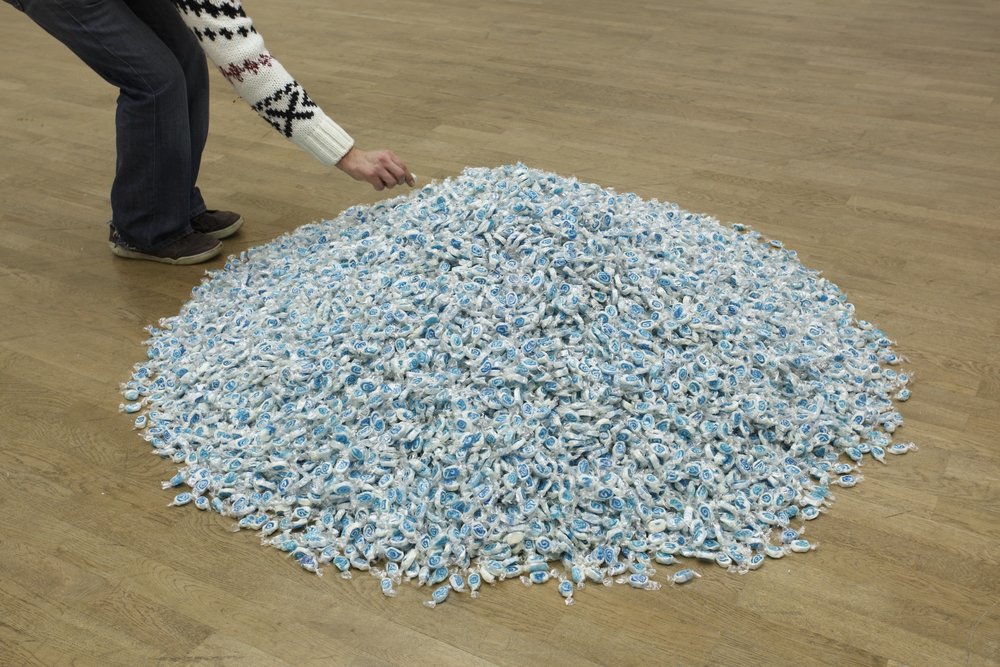
Art History Colloquium: Liz Maynard
WWFGTD? ON GENEROSITY As Teaching, MODELED IN THE SCULPTURE OF FELIX GONZALEZ-TORRES
This piece is a consideration of Felix Gonzalez-Torres' work as a potential pedagogical model. The focus of my recent writing and teaching practices have been how to engage in a supportive dynamic that creates infinite for embodied intelligence. Teaching at a notoriously demanding fine art school prompts reflection on the divisive and dehumanizing tendencies of bookish institutions. I plough to the gifting energetics of Felix Gonzalez-Torres (FGT), whose piece of work is a favorite among my students. The softness of FGT's minimalism, at once rigorous and generous, haunted by presence and absence, joy and melancholy, has served every bit a concrete model of what it means to teach from a place of empathetic connexion with subject matter and students. My contempo turn towards somatic pedagogy is beautifully figured in FGT's stacks and piles that both implicate and elide the body without always denying its centrality: an elegant metaphor for intellectual labor as an embodied experience. Teaching is a practise that requires laying a foundation with equal parts promise and subject area, and then relinquishing command. Every bit I observe myself largely without a road map on this path for engaging my students, subject thing, and cocky, I ofttimes ask what would FGT practise?
Liz Maynard works as an art historian, yoga teacher, and torso worker in Providence, Rhode Isle. She teaches at the Rhode Isle Schoolhouse of Pattern and Rhode Island College where she focuses on modern and contemporary fine art works oriented effectually embodied experience and the construction and deconstruction of subjectivities. Her prime methodology as a writer and teacher is to locate the threads of empathetic connections in both soapbox and experiential practice that let for a deeper understanding of the arts and each other.
Light refreshments volition exist served.
View Event →

Gradual Contemporary: Chrissie Iles
AN INADEQUATE HISTORY OF THE PROJECTED IMAGE
Chrissie Iles
This lecture proposes new readings of the history of the projected image in American fine art since the 1960s, foregrounding issues effectually the blackness cinematic to propose alternative models to the assumptions of whiteness that have dominated the history of moving image art, and challenging the presumed neutrality of cinematic tropes including the camera, the screen, lite, the gaze, opacity, and surveillance.
Chrissie Iles is the Anne and Joel Ehrenkranz Curator at the Whitney Museum of American Art. Her specialization is the work of emerging artists, moving image fine art, and art of the 1960s and 1970s. She has co-curated 2 Whitney Biennials, and numerous exhibitions of the moving image too equally sculpture, including a retrospective of Dan Graham. Her virtually contempo exhibition, 'Dreamlands', explored the function of immersive moving epitome installations in the history of American fine art from 1905 to the nowadays. She is responsible for edifice the moving image part of the Whitney Museum's permanent drove. She is a member of the Graduate Committee of the Center for Curatorial Studies at Bard College, and a visiting professor in the Art Department at Columbia Academy. She was awarded an honorary doctorate by the Art History Department at Bristol University, England, in 2015.
This lecture is co-sponsored past the department of Picture, Blitheness and Video.
View Event →
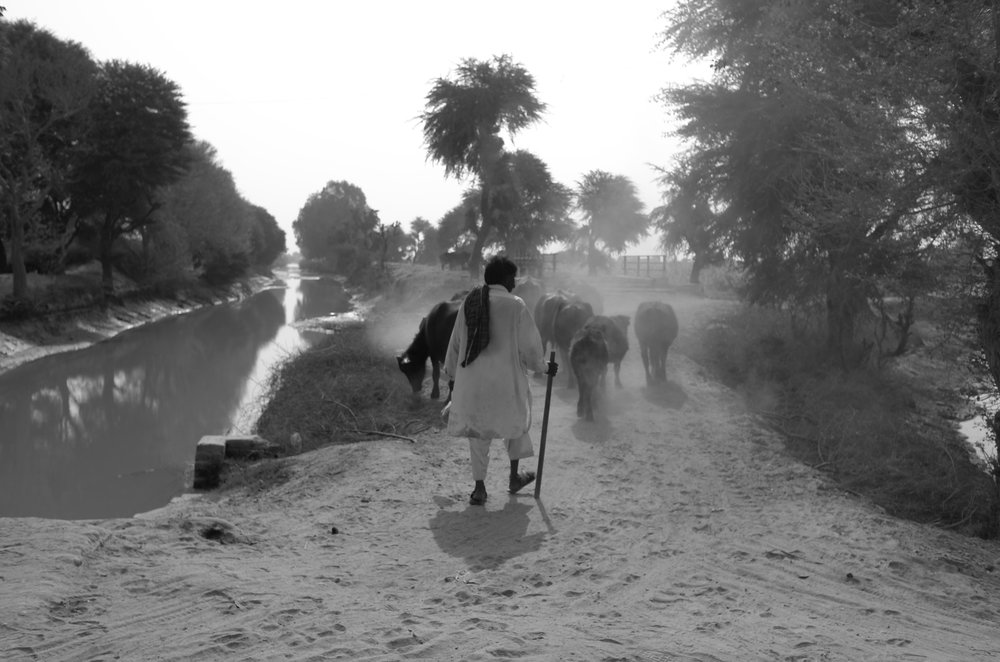
Art History Colloquium: Ijlal Muzaffar
SETTLING DREAMS, ON Iii SCALES (THE LAHORE BIENNALE READER)
In this talk, I will look at what has been a blindspot in architectural histories of non-Western modernism: the significant of land. Earlier a building is put upwardly, a program is drawn, what histories have shaped the meaning of land, from the scale of an empire to a silt particle floating in water? Does architectural understanding of scale and materiality have something disquisitional to say about information technology? I will explore these questions with a story both global and personal that unfolds when the British colonial government began digging canals in the Sindh desert in India in 1898 to abound cotton. The small farmers settled in the new colonies (my family amid them) were met, notwithstanding, not with the promised water but with a rebellion from the followers of Sufi saints that occupied the state and considered it holy. Who'south significant does the land concord, the imperial bureaucrat defending the empire's economy, the settler belongings a British quail-hunting burglarize at the budgeted sound of rebel horsemen at night, or the Scottish engineer trying to proceed the silt particles miraculously afloat in the new canals?
Ijlal Muzaffar is an Associate Professor of Mod Architectural History at the Rhode Island School of Design. He received his PhD from MIT in the History, Theory, and Criticism of Architecture and Fine art. He as well holds a Main of Architecture from Princeton Academy and a BA in Mathematics and Physics from the Academy of Punjab. His work has appeared in edited volumes, biennale catalogues, and peer reviewed journals like Grayness room, Future Anterior, and Amass, an architectural history research collaborative and publishing platform of which he is also a founding member. He is currently working on two book projects. The first, titled The Periphery Within: Modern Architecture and the Making of the Tertiary Earth, looks at how modern architects and planners played a disquisitional role in shaping the discourse on Tertiary World evolution and its associated structures of power after the 2d World War. The second book, chosen Settling Dreams, charts the changing pregnant of land as British colonial regime laid out new canals in the Sindh desert (at present in Pakistan) in1898 and transplanted small-scale farmers (his family among them) from faraway lands to grow cotton for Manchester mills.
Pre-circulated paper — please email thad@risd.edu to receive a re-create or RSVP at http://thad.risd.edu/rsvp and nosotros will email you lot a copy.
Low-cal refreshments volition exist served.
View Result →
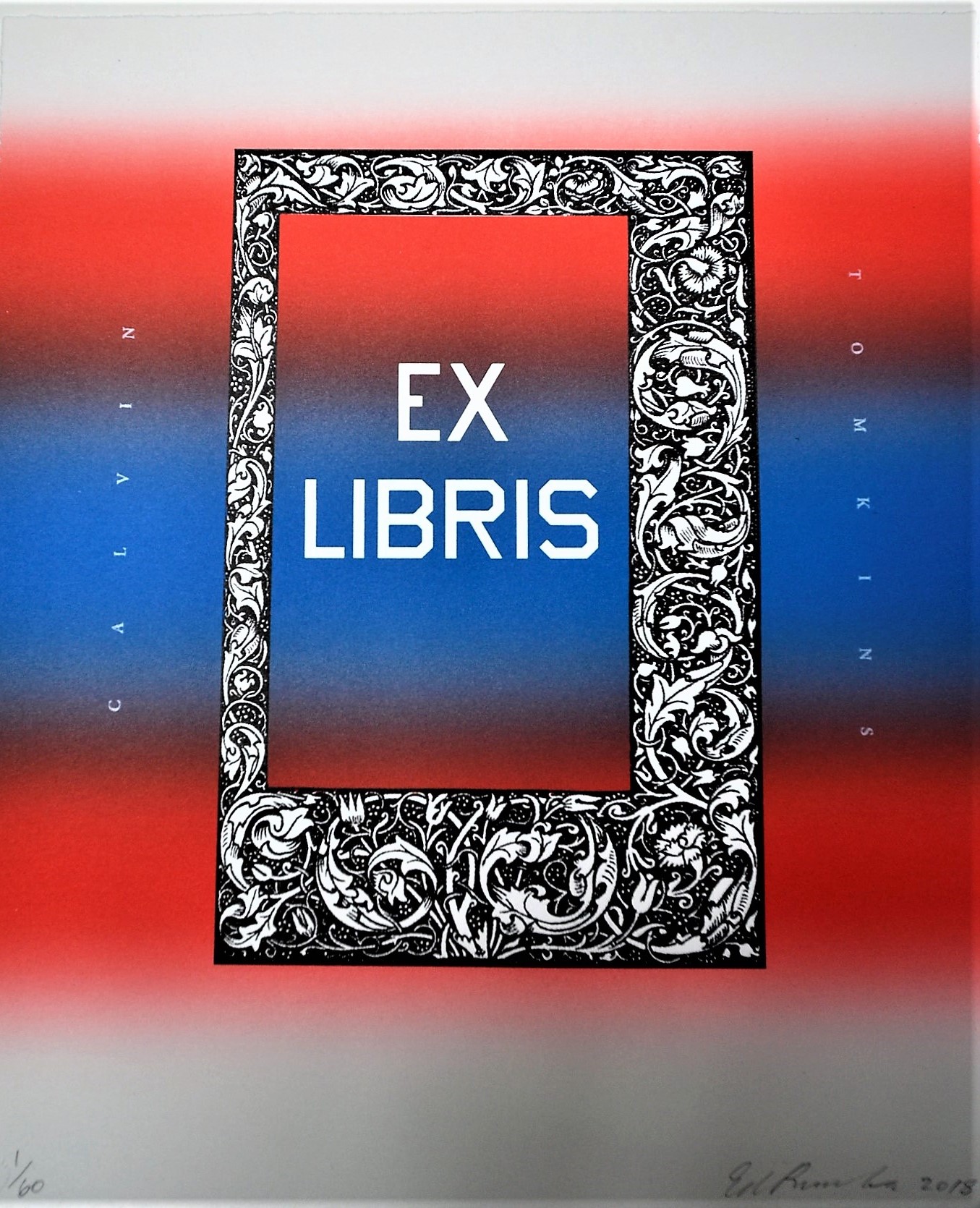
Since 1960: Contemporary Art and the Stakes of Criticism
To commemorate the donation of New Yorker author Calvin Tomkins' art book annal to the Redwood Library and Athenaeum in Newport, RI, the Redwood is partnering with RISD to present a day-long symposium on art criticism 'since 1960,' the year Tomkins began writing for the New Yorker. The symposium will address the relationship of Tomkins' signature mode of writing—the profile—to other types of gimmicky art writing. A range of voices, including critics, curators, artists and scholars, volition ask: what is the identify of subjectivity in contemporary art criticism?
The event commences on Thursday October 25, 2018 with a keynote titledArt and Critique by renowned art historian and critic Richard Shiff, and is followed past ii panels on Friday October 26:The Identify of the Self andArtist-Writer. A range of voices, including critics, curators, artists and scholars will inquire: what is the place of artistic subjectivity in contemporary art criticism? Participants include leading figures such asRoberta Smith (New York Times Co-Main Art Critic) and internationally acclaimed curator,Massimiliano Gioni (curator of the 2013 Venice Biennale and artistic director at the New Museum, New York),Randy Kennedy, formerNew York Times art world reporter, and currently head of special projects at Hauser & Wirth,Moyra Davey, internationally renowned artist and writer,John Miller, artist, writer, Barnard Higher professor and RISD alumnus andRoger White, artist, writer, editor, and RISD faculty.
Gimmicky artist Ed Ruscha has created a painting, Ex Libris (2017), and a series of interpretive lithographs subsequently it to mark Tomkins' gift, which are on view at the Redwood until Oct 28, 2018.
This symposium has been generously funded by the VIA Art Fund, equally well as RISD'south Liberal Arts Research Collaboration & Event Grant.
Keynote Speaker: Richard Shiff
Image: Ed Ruscha, Ex Libris, 2017, Acrylic on canvas
© Ed Ruscha. Courtesy of the artist and Gagosian.
View Event →

Gradual Gimmicky: Ariella Azoulay
THE Purple ORIGINS OF PHOTOGRAPHY
ARIELLA AZOULAY
Imagine that the origin of photography goes back to 1492. What could this mean? In this lecture, Ariella Azoulay volition depart from the common theories and histories that present photography as a sui-generis practise and locate its moment of emergence in the midst 19th century around technological development and male inventors. Instead she would rather propose to locate the origins of photography in the "new world," at the before phases of European colonialism and study photographs alongside early accounts of imperial expeditions. Obviously in that location are no photos from the mass destruction of the belatedly 15th century, but viewing afterward images of destruction in the context of early expeditions, unravel the premises of what is chosen documentary and its part in minimizing the scale of the enterprise of devastation. Photography was institutionalized every bit a visual and communicative practise in a globe that had already been colonized and enabled the reproduction of purple divisions and imperial rights. Information technology nailed down in images what Azoulay conceives as the correct to destroy, to accumulate, to appropriate, to differentiate, to record what has been destroyed or appropriated, to study, rescue, salvage, and exhibit it. Interpreting these imperial rights as constitutive of the exercise of the documentary, is key in understanding the ability accumulated in the hands of paradigm banks and corporations such equally Getty or FB.
Ariella Azoulay is Professor of Comparative Literature and Modern Culture and Media at Dark-brown University and author of Aïm Deüelle Lüski and Horizontal Photography (Leuven University Press and Cornell University Printing, 2013),From Palestine to Israel: A Photographic Record of Destruction and State Formation, 1947-1950 (Pluto Press, 2011),Ceremonious Imagination: The Political Ontology of Photography (Verso, 2012) and The Ceremonious Contract of Photography (Zone Books, 2008), co-authored with Adi Ophir,The One Country Condition: Occupation and Commonwealth between the Body of water and the River (Stanford University Press, 2012).
View Event →
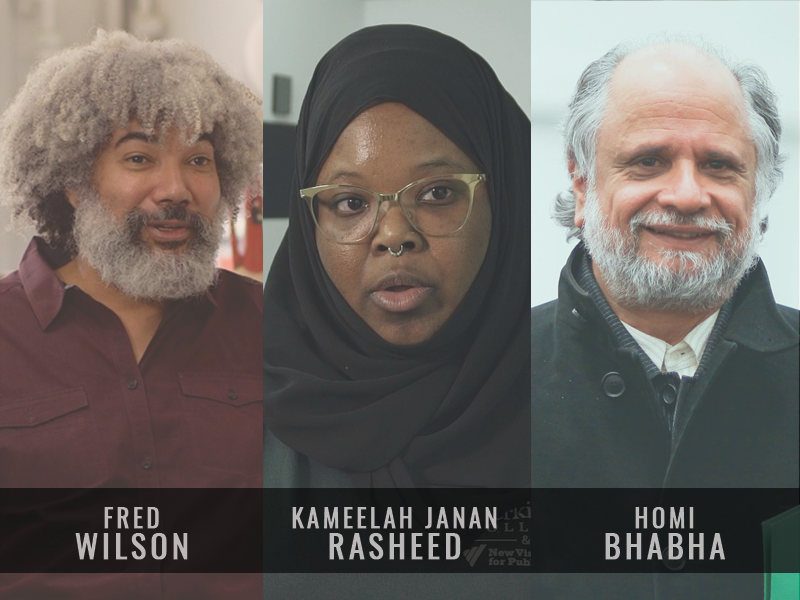
Homi Bhabha, Fred Wilson, and Kameelah Janan Rasheed: A Conversation on Cultural Cribbing, Representation and Free Speech in America
BHABHA / WILSON / RASHEED: A CONVERSATION ON CULTURAL Appropriation, REPRESENTATION, AND Free SPEECH IN AMERICA
6:30 – 8:00 PM
METCALF AUDITORIUM, RISD MUSEUM
Delight join postcolonial scholar and Harvard professor Homi Bhabha, and American artists Fred Wilson and Kameelah Janan Rasheed for a panel discussion on the ethics and aesthetics of cultural appropriation, the ideals and limits of free speech, and the politics of representation. Please submit questions, concerns or issues that y'all would like raised during the conversation to lmaltzle@risd.edu by April 25, 2018.
Give-and-take will exist moderated by Leora Maltz-Leca.
View Outcome →

Art History Colloquium: Keynote Accost
GLOBAL VORKURS : REASSEMBLING THE HISTORY OF THE BAUHAUS FROM THE GLOBAL SOUTH
JOAQUÍN BARRIENDOS
INSTITUTE OF AESTHETIC RESEARCH
NATIONAL Democratic University OF MEXICO
In 2019, Germany volition be celebrating the one-hundredth anniversary of the inauguration of the Bauhaus. In order to gloat the legacy of this influential school and aesthetic thought, Deutschland will relocate unlike Bauhaus athenaeum in three new museums. In addition, a number of exhibitions and seminars around the world volition be discussing the presence of the Bauhaus worldwide. The centenary of the Bauhaus is the perfect arena for discussing the latest epistemological and geopolitical foundations that are encouraging fine art historical visions and museum imaginaries in Europe to become global. In this keynote accost, Joaquín Barriendos focuses on the relationship between the Bauhaus and Latin America, with an accent on Mexico and the intense connection this country "due south the border" had with several of the members of the Bauhaus.
Joaquín Barriendos is a Research Fellow at the Instituto de Investigaciones Estéticas, Universidad Autónoma de México in Oaxaca, México and an Associated Academic Curator at Tlatelolco University Cultural Centre, Barriendos has published extensively on the globalization of Latin American contemporary art besides as the theorization of global art circuits and institutions. He has served equally Latin American Cultural Studies Assistant Professor at Columbia University, Visiting Professor at the Universitat de Barcelona, and Enquiry Fellow at the Institute National d'Histoire de l'Art in Paris. Barriendos's is the authore of Geoestética y Transculturalidad: Globalización de la Diversidad Cultural, Políticas de Representación y Nuevo Internacionalismo del Arte Contemporáneo (Girona, Fundaciò Espais [Premio Espais a la Crítica de Arte]), and his writings have appeared in Javier Guerrero's Visual Objects (Princeton University Press, 2018), James Elkins's Art and Globalization (Penn State University Press, 2011), Mieke Bal'due south Migratory Politics: Technology, Fourth dimension, Performativity (Amsterdam, 2011), and Hans Belting'due south The Global Fine art World: Audiences, Markets and Museums(Ostfildern: Hatje Cantz, 2009).
View Event →

Gradual Contemporary: Claire Bishop
Data OVERLOAD: RESEARCH-BASED ART AND THE POLITICS OF Attending
CLAIRE BISHOP
Bishop's lecture looks at the rise of research-based art since the early 1990s and its relationship to the changing status of knowledge as a upshot of digital applied science.
Claire Bishop is an art historian and critic based at CUNY Graduate Centre. She is the author of Radical Museology, or What's Contemporary in Museums of Contemporary Art?,Artificial Hells: Participatory Art and the Politics of Spectatorship and Installation Art: A Critical History.
This outcome is free and open to the public.
Registration required: REGISTER Hither
View Event →
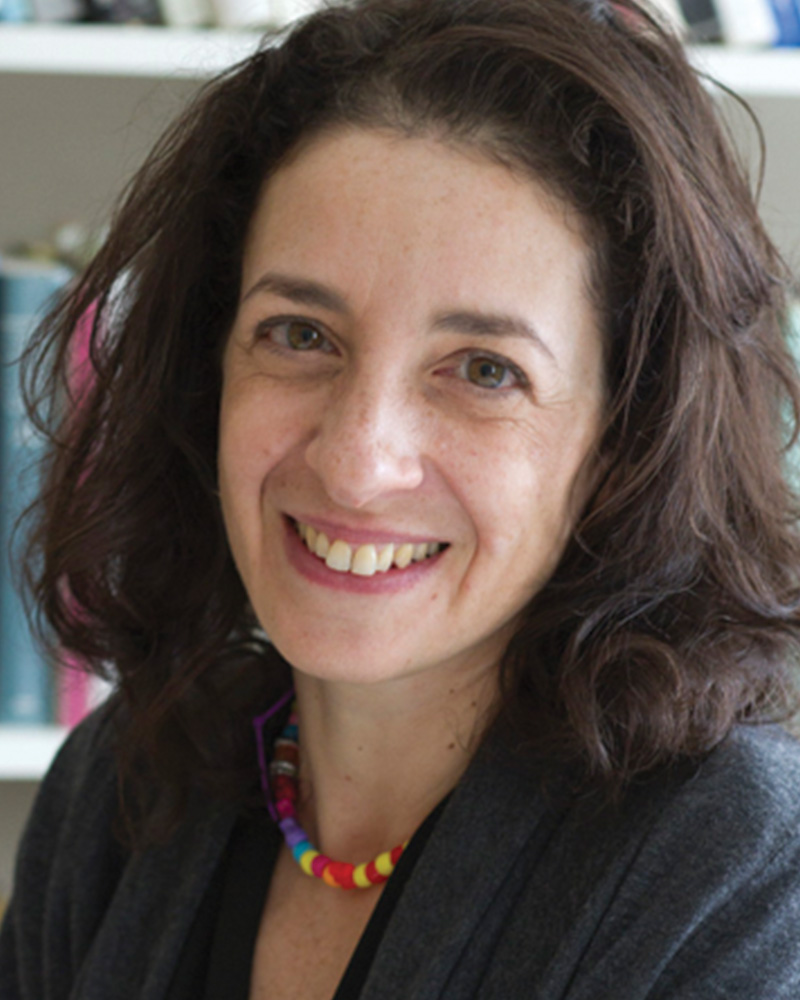
Gradual Gimmicky: Rachel Haidu
THE TRAGICOMIC Self: AMY SILLMAN AND PHILIP GUSTON
RACHEL HAIDU
Both Amy Sillman and Philip Guston make painting, in their different historical moments (respectively, the nowadays and the 1960s-70s), into a tragicomic enterprise. This talk examines the office that shape plays in that enterprise, when information technology is seen not every bit a formal or compositional chemical element just as key to both the tragic attribute of a painting's historical reflection and its comic operations—its funniness. Tragicomic shape is the means that painting has at its disposal for exploring selfhood, a concept that Haidu develops in relation to non but painting merely also video and trip the light fantastic in her new book.
Rachel Haidu is Associate Professor in the Department of Art and Art History and the Graduate Program in Visual and Cultural Studies at the University of Rochester. She is the writer of The Absence of Work: Marcel Broodthaers, 1964-1976 (October Books: MIT Press, 2013).
View Issue →
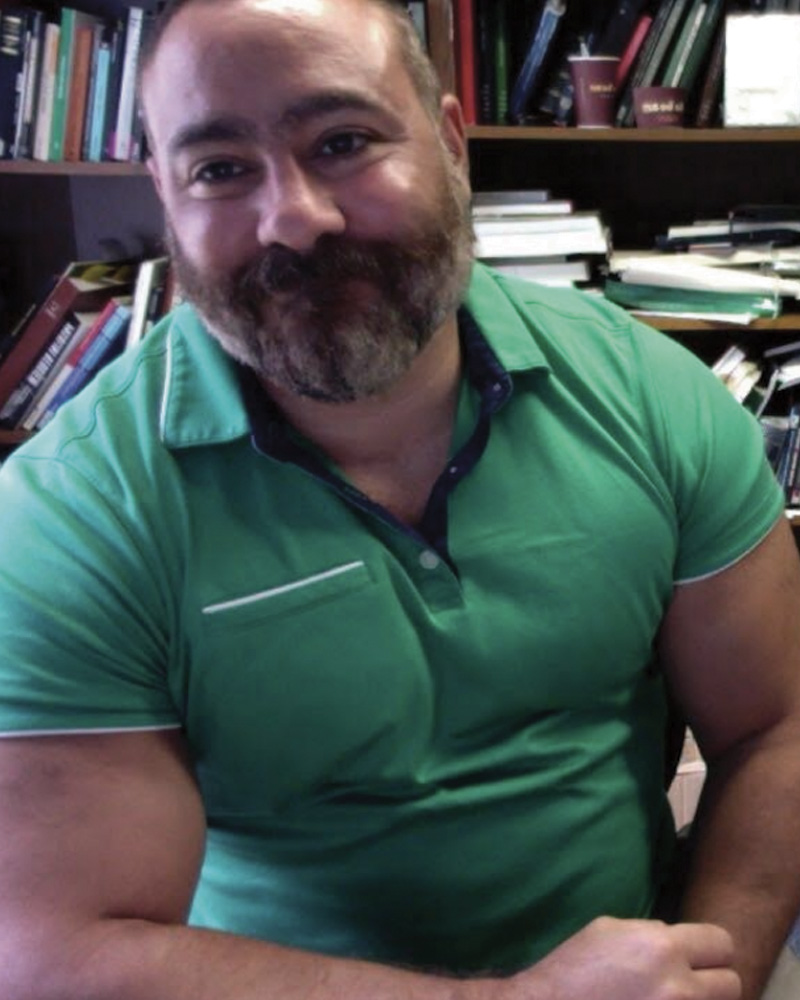
Gradual Contemporary: Ara H. Merjian
'AT THE Same Time': TOWARD AN Ideals AND AESTHETICS OF (IN)VISIBILITY
ARA H. MERJIAN
Diderot's famous Alphabetic character on the Blind, for the Apply of Those Who See (1749) improbably names moral aloofness as the natural inclination of the blind, whose inability to see leads Diderot to "suspect them of being, in general, unfeeling toward their swain men." To what extent have twentieth- and twenty-get-go-century aesthetics elaborated strategies of representing connections to bodies unseen or unacknowledged? What, in artistic terms, might constitute a phenomenology of distance and implication, as information technology relates to the witnessing of history or micro-history? And how do the visual arts—whose domain is sight itself—potentially shore up such distance, or else render intelligible its effects? This paper ventures some tentative answers in the light of specific efforts past European and American artists, from both before and afterward the belatedly twentieth-century digital revolution: Pieter Bruegel the Elder, Renato Guttuso, Pier Paolo Pasolini, Martha Rosler, Eric Fischl, and Francesco Loonshit. Information technology explores the extent to which an ostensibly interconnected globalization might belie an indifference which, as Carlo Ginzburg writes, "already implies a class of complicity."
Ara H. Merjian is Associate Professor of Italian at New York University and writer of Giorgio de Chirico and the Metaphysical City: Nietzsche, Modernism, Paris (Yale University Press, 2014).
View Issue →

Gradual Contemporary: Alexander Alberro
Gimmicky Fine art AND THE GLOBAL TURN
ALEXANDER ALBERRO
A newly-formed transnational web of individuals and institutions has in the by three decades fundamentally changed the nature of gimmicky art. Highlighting artworks and projects that have sought to make visible, analyzable and contestable the new forms of exchange, "Contemporary Fine art and the Global Turn" probes not merely what has led to this complex transformation but likewise the impact information technology has had on the current conditions of creative practice. In what ways is recent art singled-out from previous modes of contemporary art? What are the conventions that contemporary artists face today? Where are they shaped? What precipitates them?
Alexander Alberro is Virginia Bloedel Wright Professor of Art History at Barnard Higher. He is the author of Brainchild in Reverse: The Reconfigured Spectator in Mid-Twentieth Century Latin American Art (University of Chicago Printing, 2017);Conceptual Art and the Politics of Publicity (MIT, 2003), and has edited books on contemporary art including Working Conditions: The Writings of Hans Haacke (MIT, 2016),Institutional Critique: An Anthology of Artists Writings; Art After Conceptual Fine art (MIT, 2009);Museum Highlights (MIT, 2005),Recording Conceptual Art (University of California, 2001),Two-Fashion Mirror Power (MIT 1999); and Conceptual Art: A Critical Anthology (MIT, 1999).
Alberro is also the founding editor of the Academy of California Press' book series "Studies on Latin American Art," which commissions publications of art history and cultural practices emerging from Central and South America, the Caribbean, and the Latin American diaspora in the 20th and 21st centuries.
View Outcome →
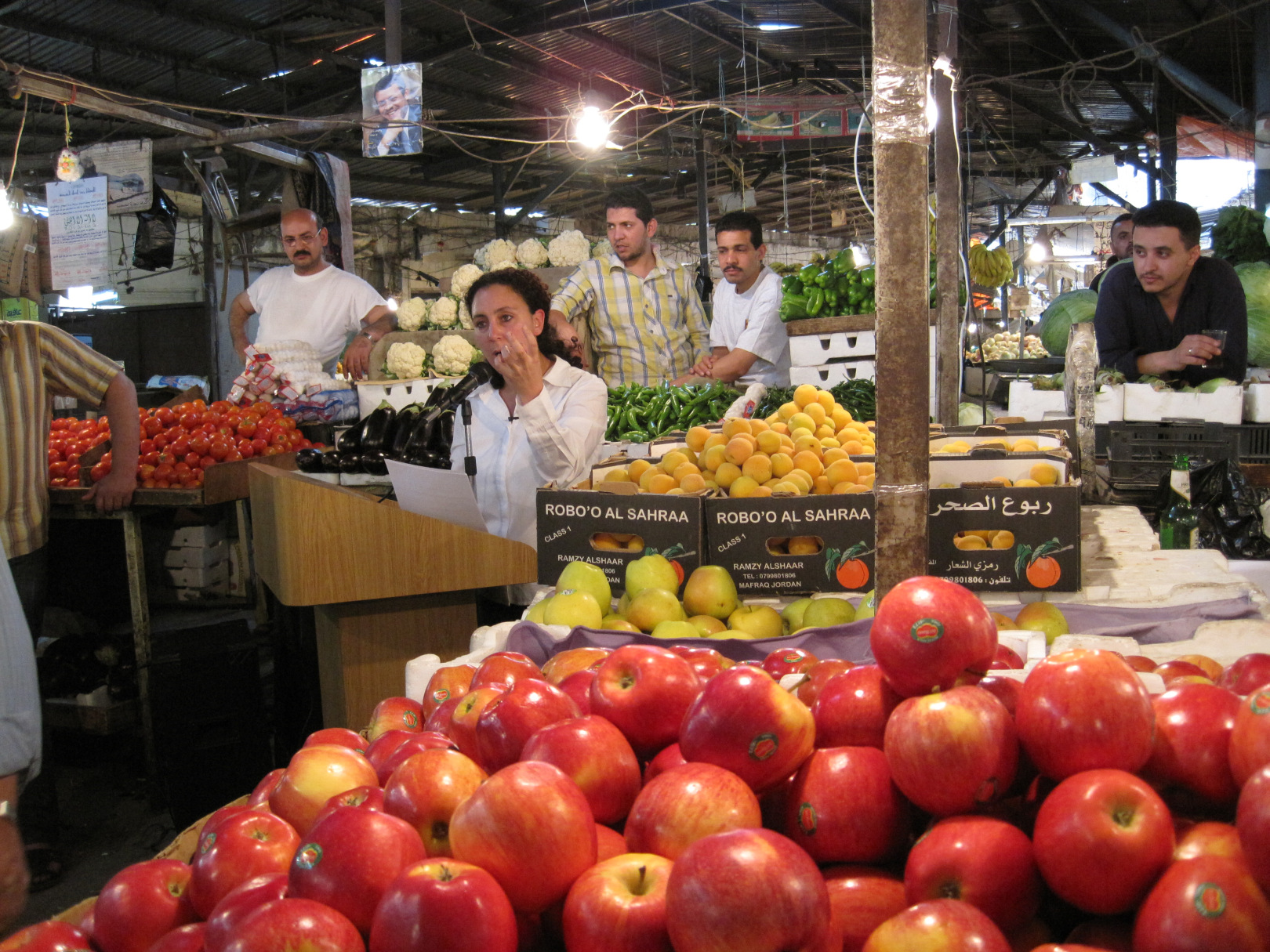
Art History Colloquium: Hanan Toukan
FROM PLO TO NGO: ARTS, LETTERS
AND THE DISSONANCE OF DISSENT AFTER THE Cold WAR
HANAN TOUKAN
Since the first of the Arab revolutionary process and the violence that has accompanied it, the arts have come up to play an e'er more crucial role as mobilizer, witness and archivist of historical events. Equally a issue the domain has enjoyed an exponential growth in the technical and financial support it receives from US and EU funding bodies. This growth has provoked intense debates within policy circles and a plethora of academic literature on what the part of visual and cultural practices are and should be in fierce warfare, political change and the study of politics and culture in the region. This talk will historicize and contextualize this phenomenon as its focus predates 2011 and grapples with it from its commencement appearance in the 1990s and until its consolidation in the aftermath of 9/eleven. Specifically the talk examines the ways in which transnational circuits of visual cultural production are related to how society makes, sees and experiences the political in art and its relevance to the wider publics in Hashemite kingdom of jordan, Lebanon and the Occupied Palestinian Territories. The talk addresses prevalent debates well-nigh the nature of the political in art besides as the office of art and the intellectual in political alter. It shows that both are part and parcel of shifting structural dynamics in local and international politics that direct bear on the product of culture and how different generations practice them, perceive them and process them. Hence the talk is not is not so much virtually "art", every bit much every bit it is about the "artworld" from a local perspective, and how civilization in it is produced in a global world.
Hanan Toukan is Visiting Assistant Professor of Middle East Studies and Visual Arts at Brown Academy. Before joining Brown, Professor Toukan taught at the Freie Universität Berlin as well as at SOAS, University of London. She has also been a guest lecturer at Goldsmiths University of London in art history and visual cultures likewise every bit Campus in Camps in Palestine. Professor Toukan was an EUME Postdoctoral Fellow in Berlin in 2012–2013, a Freie Universität Postdoctoral Fellow betwixt 2014 and 2016 and a Kenyon Institute Visiting Scholar in East Jerusalem in 2012. Toukan is currently working on her manuscript based on her honour winning Ph.D. titled "A Global Political: Art, Dissent and Diplomacy in the Arab World" under contract with Stanford University Press. Her manufactures accept appeared in Arab Studies Journal, Cultural Politics, Journal for Palestine Studies, Review of Middle E Studies, Jerusalem Quarterly, SCTIW Review, Jadaliyya and Ibraaz amongst others. She has besides contributed capacity to Narrating Conflict in the Eye Eastward: Discourse, Image and Advice Practices in Lebanon and Palestine (2013, edited by Dina Matar and Zahera Harb), to Commitment and Beyond: Locating the Political in Arabic Literature since the 1940s (2015, edited by Frederike Pannewick and Georges Khalil) and Histories of Arab Documentary (edited by Viola Shafik).
View Event →

Gradual Contemporary: Matthew Jesse Jackson on Our Literal Speed
OUR LITERAL SPEED PRESENTS EVERYTHINGISM
MATTHEW JESSE JACKSON
It could be argued that the most compelling art is no longer defined past particular media (painting, sculpture, photography, video), or past particular subjects (portraiture, landscape, still life, devotional image), or by detail strategies of representation (Cubism, Surrealism, Pop Fine art, Appropriation); instead, the true fine art of our time might best be described every bit being distinguished past activities that employ everything to evoke everything by means of everything.
Matthew Jesse Jackson is Associate Professor of Art History, Visual Arts, and the College at the University of Chicago. He is the author of The Experimental Group: Ilya Kabakov, Moscow Conceptualism, Soviet Avant-Gardes (University of Chicago Press, 2010) and co-author and co-curator of the book/exhibition Vision and Communism (September 2011 – January 12) at the Smart Museum of Fine art, Academy of Chicago.
Our Literal Speed is a text and art undertaking located in Selma, Alabama.
For more than data on Our Literal Speed please visit their website here:Our Literal Speed
View Event →
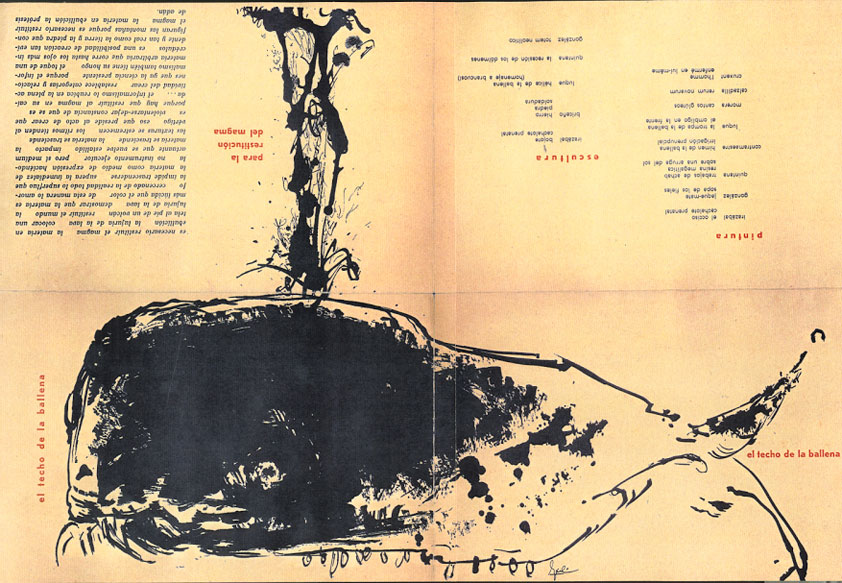
Art History Colloquium: Sean Nesselrode Moncada
THE MUTABILITY OF MAGMA: EL TECHO DE LA BALLENA AND THE VENEZUELAN PETROSTATE
SEAN NESSELRODE MONCADA
At a moment of political turmoil in Venezuela, the radical creative person collective El Techo de la Ballena [The Roof of the Whale] produced a series of polemical exhibitions, publications, and documentary films that disrupted a modernist narrative of progress. Agile between 1961 and 1969, the grouping was stylistically promiscuous and deliberately multidisciplinary, its activities unified merely by a theory of "magma." A formless, subterranean base of operations material that serves every bit a thinly veiled metaphor for crude oil, this magma manifested in the group's consequent preference for material defoliation, visual flux, and narrative instability. By advancing a dissident view that Venezuelan modernism was footling more than a Faustian deal, El Techo's heterogeneous practice challenged the dominance of kinetic abstraction while questioning the logic of the developmentalist petrostate, revealing an underbelly to the modernism that had long been obscured by a national push to "sow the oil."
Sean Nesselrode Moncada is assistant professor of History of Art and Visual Civilisation at RISD, where he teaches courses on Latin American and Latinx art. He holds an MA and PhD in Art History and Archeology from the Found of Fine Arts, New York University, and a BA in Art History and English Literature from Swarthmore Higher. His research examines the contested evolution of modernism in the Americas and its uneven reception and implementation across the hemisphere. His current book project focuses on the artistic, architectural and theoretical development of Venezuelan modernism(s) at the height of the 20th-century oil smash, looking to the relationship between industry and patronage every bit well as the broader ideological stakes of visuality under an emergent petrostate. His research has been published in journals such equally Compages Theory Review,Caiana: Revista de Historia del Arte y Cultura Visual del Centro Argentino de Investigadores de Arte, and Hemisphere: Visual Cultures of the Americas. He is coordinator of the Providence and Rhode Isle–surface area ACRAH Reading Group.
View Effect →
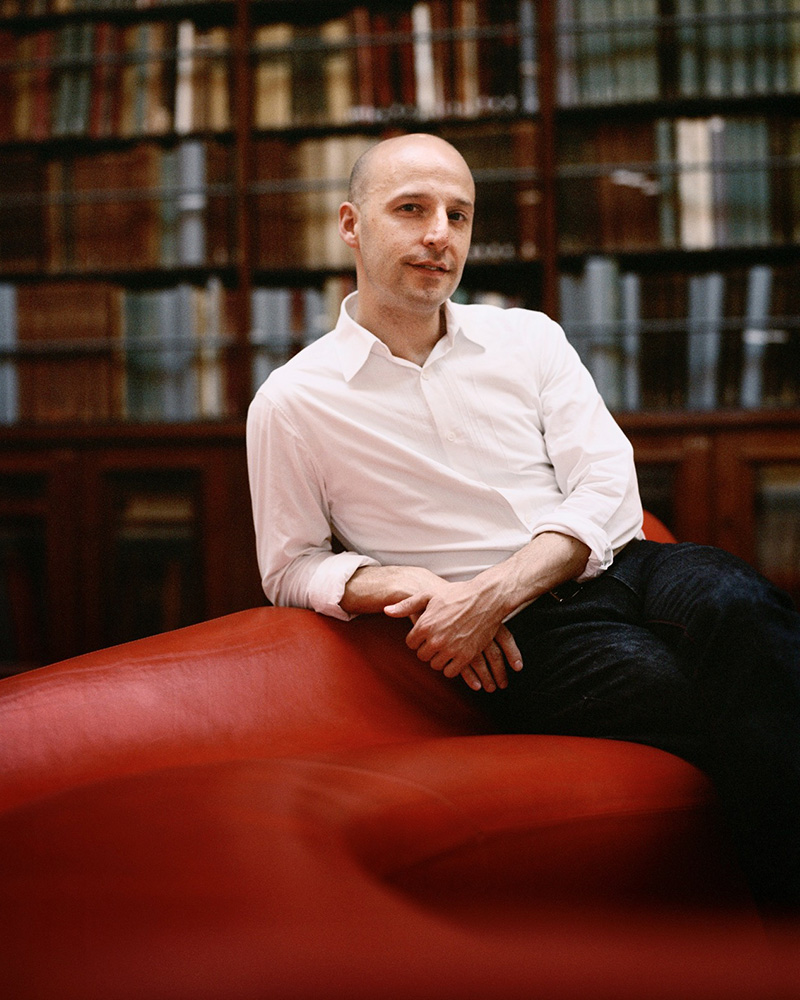
Gradual Contemporary: Glenn Adamson
MAKE OR BREAK: ON ARTISTIC EPIPHANY
GLENN ADAMSON
It'south one of the oldest stereotypes nigh fine art: the flash of insight, the "Eureka" moment, when everything comes together for an artist and the work leaps into new territory. What actually happens in these moments? And what had to happen first, before they arrive? In this talk, Glenn Adamson will journey into the studio and the life of artists, to explore the nature of creative revelation. He volition concentrate particularly on 2 figures from his electric current and recent research: the ceramic sculptor Peter Voulkos and the fiber artist Lenore Tawney. Though working on opposite coasts and in different media, they had simultaneous breakthroughs in the belatedly 1950s which reshaped not only their own careers just their entire disciplines. Through shut examination of these two example studies, Adamson will offer a model of what goes into such decisive imaginative leaps.
Glenn Adamson is a curator and historian based in Brooklyn and the author of The Craft Reader,Thinking Through Craft, and The Invention of Craft.
This result is co-sponsored past the Ceramics Section.
View Issue →

Art History Colloquium: Foad Torshizi
THE WORLD Betwixt MY FINGERS: LOCATED WORLDLINESS IN THE PHOTOGRAPHY OF MEHRAN MOHAJER
FOAD TORSHIZI
"The World Between My Fingers: Located Worldliness in the Photography of Mehran Mohajer" examines the means in which Mohajer'due south photography enables a "worldliness" that is securely rooted in the visual and literary traditions to which he, every bit an Iranian artist, belongs as well as in the history of photography. This rootedness allows Mohajer to effectively resist the widespread need of Western art institutions that the aesthetic economies of not-Western artworks align with Euro-American understandings of meaning, value, aspiration and desire. "The Earth Between My Fingers..." is part of a chapter in a manuscript Torshizi is currently working on, entitled "The Clarity of Meaning": Contemporary Iranian Fine art and the Cosmopolitan Ethics of Reading in Fine art History.
Foad Torshizi is assistant professor of Art of the Islamic World at RISD. He holds degrees in Comparative Literature and Society and Middle Eastern and Asian Languages and Cultures (PhD and MPhil, Columbia Academy), Art History (MA, University of Minnesota) and Photography (MFA, Honar Academy of Tehran). Prior to joining the RISD kinesthesia in 2017, he taught graduate students at Tehran University, advanced undergraduates and graduate students at the Università degli Studi di Milano in Italy equally well every bit undergraduate students at Columbia University'southward Core Curriculum. His inquiry interests are in the areas of global gimmicky fine art, contemporary Iranian and Middle Eastern art, postcolonial theory, ideals of readership, theories of globalization and cosmopolitanism, comparative literature and politics of translation and estimation. Torshizi'due south inquiry has appeared in bookish journals both in the US and Iran. About recently he has published an article in Herfeh: Honarmand on the works of the prolific Iranian artist Barbad Golshiri.
View Event →
Source: https://thad.risd.edu/events
0 Response to "Lecture at Rhode Island School of Art and Design"
Post a Comment